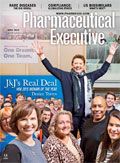The New Health: Navigating with Nash
Pharmaceutical Executive
Learnings gleaned from our annual EAB meeting, hosted this year by Dr. David Nash, Dean of the Thomas Jefferson University School of Population Health.
NOTHING IS AS DESTRUCTIVE TO B2B JOURNALISM as slaking the thirst for content from the same familiar well of sources. It is particularly harmful in healthcare, a sector composed of many separate parts, whose isolation is reinforced by the guild-like behavior of professional medical practice; a historically dependent and hugely uninformed patient population; and government regulations that reward narrow episodes of care rather than broader health outcomes. In fact, even after decades of progress in the use of drugs against diseases, in some circles it is still debatable as to whether our chosen business even qualifies as a health service.

William Looney
The ongoing struggle to define the proper place of pharmaceuticals in healthcare is evident in the pages of this month's issue. We segue from the global obsession with compliance standards, in which the inducement to prescribe is seen as behavior fraught with serious ethical implications, to the cover feature on the 2015 HBA Woman of the Year, Denice Torres of J&J. Her steady rise in the executive ranks is due to a dedication to changing that negative perception by fostering public trust in the company's products: where the simple act of opening a bottle of pills is a seamless-and tension-free-act of individual consumer empowerment.
Pharm Exec is moving in the same direction, seeking ways to diversify our content through better connections with stakeholders in adjacent, non-traditional parts of the global health community. A vital driver of this effort is Pharm Exec's Editorial Advisory Board (EAB), 31 experts representing nearly all segments of the modern healthcare enterprise as well as numerous geographies, from Russia to India to Canada as well as the US.
This year's EAB meeting was held on Feb. 25, hosted by Dr. David Nash, Dean of the Thomas Jefferson University School of Population Health in Philadelphia, and a leading expert on this most externally driven, integrative approach to health management. Population health is founded on the assertion that 20% or less of an individual's well-being depends on the formal health system. Despite the vast amounts of money spent on acute care, where you live-your zip code-is a more reliable indicator of health status, along with family background, gender, and education, all of which tend to encourage reliance on lower cost preventive health behaviors.
Founded in 2009, the School's mission is to create leaders for the "no outcomes, no income" healthcare system taking root in the US, with an annual budget of $6 million that funds five separate masters degree programs for 300 students from 30 countries, many of whom are practicing physicians interested in managing ACOs and other emerging players in financing and delivery. The School also has an active research program, with support from key industry players like Janssen and Eli Lilly.
Nash and the EAB members underscored the need for more industry cooperation with the population health community around an evidence-for-outcomes research agenda. "In population health we have tremendous analytics capabilities. It's in the interest of the R&D industry to make better use of the data to structure how the next generation of health decision-makers approaches the allocation of increasingly scarce resources. If you don't, others will do it for you," Nash told the EAB.
For more on Nash and population health, refer to our cover profile in Pharm Exec's March 2014 issue (pharmexec.com/population-health-call-community). Nash stands out as a restlessly inventive and colorful anomaly in a sector marked by gray shades of careful circumspection-and if you require proof, check out those socks in the group photo at below.

EAB members, seated (left to right): Kristen Spensieri; Sanjiv Sharma; Kenneth Kaitin: Joanna Breitstein: Dr. David Nash; William Looney; Dr. Graham Hughes; Michael Swanick. Standing (left to right): Les Funtleyder; Michael Ringel; Murray Aitken; Mason Tenaglia; Bob Jansen; Rajesh Nair; Terry Hisey; Joseph Truitt; Terese Waldron; Peter Young; Rob Dhoble; Bernard Lachapelle; Frederic Boucheseiche; Don Creighton; Ian Wilcox; John Furey (Photo: John Halpern)
William Looney Editor-in-Chief wlooney@advanstar.com Follow Bill on Twitter: @BillPharmExec

Trump: 'Major Tariff' on Pharmaceuticals Coming Soon
Published: April 9th 2025 | Updated: April 9th 2025“We’re going to tariff our pharmaceuticals, and once we do that, they are going to come rushing back into our country," President Donald J. Trump said during a Tuesday night dinner in Washington.
Trump: 'Major Tariff' on Pharmaceuticals Coming Soon
Published: April 9th 2025 | Updated: April 9th 2025“We’re going to tariff our pharmaceuticals, and once we do that, they are going to come rushing back into our country," President Donald J. Trump said during a Tuesday night dinner in Washington.
2 Commerce Drive
Cranbury, NJ 08512
All rights reserved.